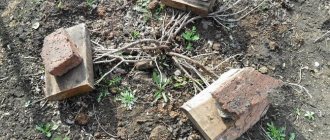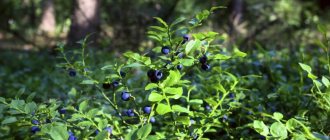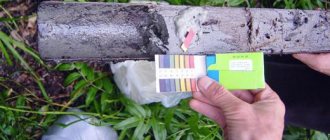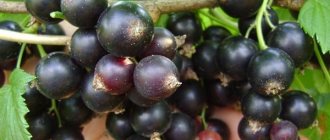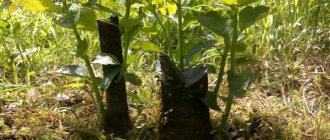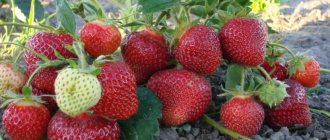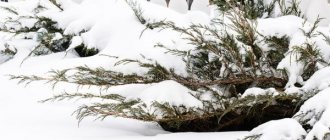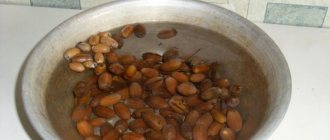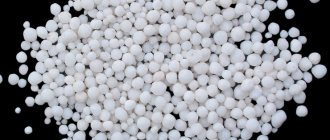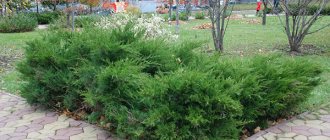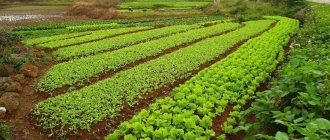History of selection
The variety comes from the result of crossing the Russian species Altai dessert and the well-known Swedish currant Kajaanin Musta-Tamas. The first seedlings of Titania have been in the descriptions of Russian summer residents since the late 90s. Since then, the plant has received good reviews and is grown not only in areas with difficult climates, but throughout the country.
Landing
The Titania currant variety is recommended to be planted around the perimeter of the garden. This can be done both in the fall and in the spring. Considering the size of the bushes, you need to leave about two meters of free space between them so that the currants can develop calmly in the future. It is allowed to plant currants in the form of a checkerboard, as this makes it easy to harvest. But this option is appropriate if you are going to plant large areas with this berry. Before planting a plant, you need to worry about preparing the soil:
- remove all weeds and their roots from the place you have chosen for planting;
- dig up the soil and add fertilizer there so that the plant has enough strength to grow;
- dig a hole half a meter in diameter and place a mixture of ash and leaves at the very bottom;
- we take a seedling and, tilting it a little, place it in the soil five centimeters deep, and then bury it; it is better if the top of the bush is directed towards the south or southeast;
- be sure to water the bush after planting, even if the soil is wet;
- carefully select seedlings, make sure that they are strong and fresh, and also have several shoots;
- after planting, you need to trim the bush so that only three or four buds remain; this improves the growth of lateral branches.
Appearance, characteristics of berries, ripening time, yield
Plants of this variety produce round berries of large or medium size (1.5–2.5 g). Durable skin and high sugar content make Titania an excellent raw material for all kinds of processing (jam, jam, compote) and for fresh consumption. Ripe berries have a pronounced black color, visible density, characteristic shine and an excellent currant wine-sweet taste.
Important! After ripening, these currants do not fall off, but patiently wait to be picked from the branches. If you delay picking, the berries begin to dry on the branches.
The berries contain about 6.6% sugar and 3.2% acids. The characteristics of BZHU are as follows (per 100 g):
proteins - 1 g; fats - 0.4 g; carbohydrates - 7 g; calories - 44 kcal.
From one currant bush of this variety you can collect up to 5 kg of berries. The berries ripen gradually, and the first ones can be harvested in early July.
Diseases and pests
Titania is extremely disease resistant. The threat exists only for weakened bushes growing on too acidic or waterlogged soils. In this case, it is wiser not to treat the plants with fungicides, but to modify the soil or replant the bushes. This material will tell you about brown spots on currant leaves.
The measures are traditional: spring treatment with Bordeaux mixture and destruction of diseased branches and yellowed leaves. If the bush is affected by more than 70%, it is removed entirely. Cuprozan, phthalan, and nitrafen are also used against anthracnose or columnar fluid.
Insect pests pose a greater danger:
- spider mites infect the leaves, which ultimately impairs the nutrition of the plant. Against mites, currants are sprayed with Vitafox or Apollo until the buds open;
- Treatment with rovikurt or karbofos helps against glass butterflies A solution of laundry soap is also used;
- of shoot gall midges by spraying the bush with rovikurt or ash solution - 1 tablespoon per 10 liters of water;
- The fruit sawfly is destroyed using ambush or ethaphos. Treatment is carried out immediately after flowering.
Advantages and disadvantages of the variety
- The advantages of this standard modern variety are as follows:
- large berries;
- dry picking from the stalks;
- lack of shedding of ripe fruits;
- productivity;
- transportability;
- frost resistance;
- resistance to parasites and diseases.
- The disadvantages of Titania are:
- powerful bush that requires garter;
- demands on watering and soil moisture;
- tendency to crush berries if not properly cared for;
- thickening in the absence of pruning;
- heterogeneity in the size of berries on the bush.
Characteristics of the variety
Judging by the reviews, black currant Titania is a variety that begins to bear fruit early. The first berries begin to appear in the second year of the plant’s life. The yield of black currant increases up to 7 years, then it decreases. The first 15 years of a bush’s life are productive. The number of fruits directly depends on care, soil condition, and weather conditions.
Drought resistance, frost resistance
Black Titania is a very resilient currant. Its bushes adapt to any climatic conditions and easily tolerate unexpected weather conditions. According to the description of the variety, Titania currants are able to survive winters with frosts exceeding -34 °C.
If damaged by spring frosts or a thaw followed by cold weather, Titania loses only 25% of the average harvest. Summer residents claim that without watering and pruning, in abandoned areas, bushes continue to bear black berries for decades.
The dense, leafy bush of Titania tolerates heat well, and the root system can withstand prolonged drought.
Productivity and fruiting
Titania is a medium-early ripening variety. The bushes bloom in the second half of May. After 40 days, the first black fruits appear at technical maturity. In July, the harvest period begins, which can last more than 30 days.
Black, ripe fruits are removed every 10 days, green ones are left on the branches. The final yield depends on the care and age of the bushes. On average it is:
- 2 kg from a young bush;
- from 8 to 10 kg per plant over 5 years old;
- An old or unkempt bush gives about 3 kg.
Taste characteristics of black Titania berries:
- sugars – 6.6%;
- acids – 3.2%;
- expert assessment – 4.6 points out of 5.
Important! The taste of Titania is highly dependent on soil moisture. With heavy watering or prolonged rains, black berries become more sour.
Area of application of fruits
According to reviews, not everyone likes the sour taste of Titania blackcurrant. The classic wine aftertaste and strong aroma are used in the production of light alcoholic drinks, juices, syrups, in confectionery production, and in canning. Black currants tolerate freezing well and retain their aroma when dried.
The dense pulp and elastic skin of Titania allow blackcurrants to be harvested by machine. Combined with excellent shelf life (up to 2 weeks) and transportability, this makes the crop very popular among farmers.
At home, black berries can be stored in the refrigerator for more than 10 days.
Resistance to diseases and pests
The official description of Titania currant indicates the ability to resist the following fungal infections:
- powdery mildew;
- anthracnose (bitter rot);
- white and brown spotting.
Advantages and disadvantages of the variety
The undoubted advantages of the variety are:
- Stable yield.
- Resistance to frost and heat.
- Immunity to “currant” diseases.
- Presentable appearance, keeping quality, ease of harvesting.
Disadvantages of Titania according to gardeners:
- rapid thickening of bushes;
- in one cluster there are fruits of different sizes;
- The taste of the berries is sour.
Some people consider extended fruiting periods to be a disadvantage for black currants, while others consider this property to be an important advantage of the variety.
Important! The self-fertile Titania currant produces good yields even in conditions of insufficient pollination. No partner plants are required for the culture.
Agricultural technology
Black currant is a fairly unpretentious crop and does not require much attention. You just need to maintain the conditions for its growth at the required unpretentious level and carry out watering, fertilizing and other operations on time.
Video: Currant Titania
Choosing a place and landing
The place for planting the plant is selected based on the following considerations:
- good illumination or light shading in the midday heat;
- absence of stagnation of moisture and occurrence of groundwater no higher than 1 m from the surface;
- light loose soil with good drainage;
- flat surface (neither lowland nor hilly).
Important! Acidic and clayey soil is not suitable for planting currants. If the soil is dense but not acidic, you can pour a bucket of sand or limestone into the planting hole.
For planting, select healthy seedlings of medium height with an intact root system. The branches must also be free of injuries and visible manifestations of disease. Before planting, the roots can be soaked in a weak solution of potassium permanganate.
The holes are prepared in 1–2 days - they dig a hole with a depth and a diameter of about 0.5 m. Half a bucket of humus is added to it and a bucket of water is poured into it. Before planting, dig up the soil and carefully place the plant in the hole. You need to carefully straighten the roots, sprinkle with soil, compact them a little and pour a bucket of water. When planting a plantation, it is necessary to take into account that the plants are quite spreading and there should be at least 1.8–2 m between them.
Many summer residents prefer to plant currants at an angle of about 45° to the surface of the earth. This is done for better formation of new roots and buds from the root collar compacted into the soil.
Care
Caring for a rooted seedling is not particularly difficult - the young plant needs to be watered and fed. Watering in dry times is carried out at least once a week - water that has warmed up during the day is poured into the root zone from a hose or bucket. The watering rate per bush is 10–15 liters. After the rain, the soil should be allowed to dry, loosen it well, and only after that can you begin scheduled watering.
Did you know? Currants are not only a close relative of gooseberries, to which they are very similar. The Saxifragaceae family also includes peonies, bergenia and money tree.
Feeding is carried out according to the following scheme:
- in early spring - nitrogen fertilizers;
- during the growing season before flowering - liquid or diluted organic fertilizers;
- in the fall, when digging under the plant, add 3 kg of humus with 50 g of superphosphate.
Disease and pest control
Pests do not bother the plant too much. With proper care, both parasites and fungal diseases bypass the bushes. In order not to expose the plants to the risk of getting sick, it is necessary to follow the watering regime and not overfeed the berry plants with fertilizers. If insects (most often aphids) are found on the crop, the branches and leaves must be washed with soapy water or a weak solution of potassium permanganate.
Further care for Titania
Blackcurrant is responsive to care, and if it is carried out regularly and in a timely manner, then the yield of fruits will proceed smoothly and in abundance. The plant requires increased attention at the initial stage of cultivation, since the crown is still forming on the trunk, and the root system is intensively developing. Over time, caring for the crop will become commonplace, because there are no difficulties with it. It consists in:
- performing regular watering;
- spring, autumn pruning;
- treatment against diseases and pests;
- using additional fertilizers.
In addition to these stages, you need to keep the area clean, periodically loosen the soil, especially near the tree trunk, and remove young growth.
Watering requirements
Titania loves moisture, but not too much of it, so it is strictly forbidden to overwater the plants. If precipitation occurs frequently in the region, then there is no need to specifically water the crop. To make sure that the procedure is necessary, you need to check how dry the soil is. The top layer is loosened to a depth of at least 7-8 cm. If the soil is dry, then it needs to be watered. During the season, the soil is moistened about 4-5 times. Provided that there has been no rain in the region for a long time and the air temperature is high, the currants are watered 1-2 times a week.
Attention! You cannot water berry bushes with ice water, this leads to the formation of rot on the roots.
The need for pruning bushes
The most important part of the formation of a shrub lasts the first 3 years of its life. Every year in spring, out of the total number of branches, only 3-4 of the strongest branches are left unchanged, while the rest are cut to half their length. Dried, diseased, stunted shoots are removed completely; stumps cannot be left. Then, when the bush has fully grown, pruning continues: the total number of branches should be 23-25 pieces.
Treatment against diseases and pests
The condition of leaves and branches should be monitored regularly, since the first signs of damage by pathogenic microflora appear on them. Prevention against diseases is carried out in the spring, when it is noticeably warmer outside, up to +10-15 degrees. The drugs Kuprozan, Ftalsan, Bordeaux mixture, and Nitrafen help fight most known viruses. Use chemicals strictly according to the instructions, otherwise you can harm the plant itself.
Insecticides will help against attacks by spider mites, glass beetles, sawflies and other pests: “Karbofos”, “Votafox”, “Apollo”, “Etafos”. Treatment solutions are prepared according to the manufacturer’s recommendations and the bushes and soil are treated before the currants begin to bloom. The treatment is repeated after 7-10 days.
Fertilizing with mineral fertilizers
Titania needs to be fed for regular good fruiting. A year after planting, fertilizers applied in advance are quickly washed away from the soil, so soil fertility needs to be increased. In the spring, after the snow has melted, 30 g of urea is poured under each bush. After the formation of buds, feed the currants with potassium sulfate: dilute with water (10 l) tbsp. powder and apply at the root.
After fruiting, you need to nourish the crop for the upcoming cold weather and the new season. Apply in October directly under the plant:
- humus – 5 kg;
- potassium sulfate – 2 tbsp;
- double superphosphate – 40 g.
When growing crops, you can use complex additives with a balanced composition, but they must be marked “for fruit bushes and trees.”
Reproduction
Healthy mature bushes can easily be propagated by cuttings. It is carried out in early spring, before the buds open. The tallest shoot is separated with a knife and planted obliquely in fertile soil at an angle of 45 degrees, the soil is slightly moistened and the plant is left to take root. The new seedling will grow and be ready for planting next year.
Harvesting and transportation, keeping quality of berries
As mentioned above, the currants of this variety are very easy to remove from the brush. At the same time, its integrity is not violated and no juice is released from the place of breakdown. From one bush you can remove up to 5 kg of berries during their ripening in 15–20 days.
The berries should be stored in wide boxes in bulk to a height of 5–7 cm. At a temperature of +15…+17°C, Titania currants are stored for about two weeks. In the basement or refrigerator, this period can be increased to a month, but you need to sort the fruits once a week. Currants can be transported over long distances. To do this, you need to put straw or agro-fabric in half-filled boxes to prevent the movement of the berries.
Did you know? In ancient Russian epics the name of the river Smorodinovka is found. Some historians believe that this name refers to the Moscow River, on the banks of which a lot of currants grew in those days.
The Titania currant variety immediately won its niche among other types of this berry. Summer residents and gardeners began to use it for industrial cultivation. The prospects and unpretentiousness of Titania are undeniable, so its distribution across various regions of the country is a matter of the near future.
Planting and growing
It is better to choose a place for blackcurrants around the perimeter of the site. The area intended for this crop should be cleared of weeds and their roots in advance. Dig thoroughly and apply organic and mineral fertilizers.
Taking into account the growth of the crown of Titania bushes over 1.5 m, then dig planting holes at a distance of 1.8 -2 meters, the same distance should be between the rows. Planting bushes in a staggered pattern will make harvesting and movement between plants easier.
The size of the pit cannot be less than 0.4 m by 0.4 m; we pour ash and forest leaves into the bottom.
Place the seedling in the hole at an angle to the ground. This position will allow the formation of additional roots faster and ensure good growth of the plant. It is advisable to direct the top to the south or southeast. We bury the root collar into the soil at least 5 cm. Regardless of the condition of the soil, we water the seedling.
For planting, it is advisable to choose seedlings with at least one long, well-developed shoot. After planting, we cut it by half, leaving at least 3-5 buds. This pruning causes increased growth of side shoots. You can plant currants both in autumn and in spring.
Considering that Titania begins to grow quite early in the spring, autumn planting is preferable. It has been experimentally proven that this variety can withstand frost down to -34 degrees, so the plant does not need additional shelter.
In spring, it is necessary to cut off the tops of the shoots, which will affect the appearance of branches and increase the yield. Treat with fungicides and feed with mineral and organic fertilizers. Titania easily tolerates hot, dry weather, but in case of prolonged drought, the plant must be watered. In damp, rainy summers, its berries may be more sour than usual.
Without replanting and reducing yield, Titania grows in one place for up to 15 years, but it is important to periodically remove old shoots. To renew the bush with young shoots, every year in the spring you need to dig in one side shoot, which will give new stems
It is better to purchase varietal currants from trusted producers, in specialized fruit nurseries, then Titania will not let you down and will give a good harvest.
Harvesting Titania on video:
Methods for propagating currants
Titania is grown by layering. In spring, a strong shoot is selected and pinned to the ground. In order for the branch to quickly take root, the integrity of the cover is violated. By autumn, the rooted branch is separated from the mother bush and transplanted to a permanent place.
The variety produces many shoots per season. Cuttings 20 centimeters long are cut in the spring and planted in the substrate. By autumn, roots appear. The cuttings are transplanted to a permanent place. Gardeners like to use the second option. The peculiarity of the variety is the rapid survival of cuttings.
Pros and cons of culture
Positive properties of the Titania variety:
- The harvest is harvested in three stages, which makes it possible to enjoy the berries.
- Strong immunity.
- Tolerates frost and drought.
- The berries do not fall off during the ripening process.
- High yield.
- Perfectly tolerates transportation over long distances.
- When propagated by cuttings, it quickly takes root.
Minuses:
- High requirements of agricultural technology.
- Improper care leads to crushing of berries.
- We have to get rid of the growth.
- Loves moist soil.
- Rainy summer affects the taste of berries.
- Berries of different sizes.
Negative characteristics do not prevent Titania from being grown on an industrial scale in the countryside.
